Traditionalist Issues
 |
 |
 |
 |
 |
 |
 |
Dialogue Mass - CXVI
Pope Benedict XVI Continued the
Conciliar Revolution
In 1966, the same year he was appointed to a chair in dogmatic theology at the University of Tübingen, the then Fr. Joseph Ratzinger criticized the Tiara as a form of “dangerous triumphalism,” adding insult to injury by implying that those who wore it were guilty of “self-glorification”:
“So long as the Church is on pilgrimage on the earth, she has no ground to boast of her own works. Such self-glorification could become more dangerous than the Sedia Gestatoria (1) and the Tiara, which are more likely to elicit a smile than a feeling of pride.” (2)
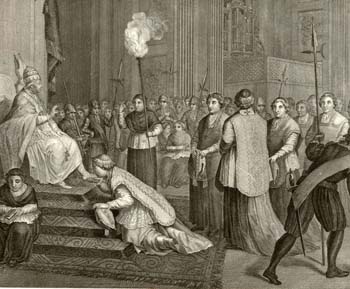 But this assertion is unjustified, for these two items of papal regalia had nothing to do with boastfulness or self-aggrandisement. This is evident from
a centuries-old custom performed as part of papal coronations. While the newly-crowned Pope, still wearing his Tiara, was being carried in the Sedia Gestatoria, the procession would stop three times, and a master of ceremonies, brandishing a piece of burning flax, would chant this warning in a mournful tone: Pater Sancte: Sic transit gloria mundi. (Holy Father, thus passes the glory of the world).
But this assertion is unjustified, for these two items of papal regalia had nothing to do with boastfulness or self-aggrandisement. This is evident from
a centuries-old custom performed as part of papal coronations. While the newly-crowned Pope, still wearing his Tiara, was being carried in the Sedia Gestatoria, the procession would stop three times, and a master of ceremonies, brandishing a piece of burning flax, would chant this warning in a mournful tone: Pater Sancte: Sic transit gloria mundi. (Holy Father, thus passes the glory of the world).
These words served as a reminder to the Pope of the transitory nature of earthly life and worldly honors, lest he should be tempted to see his position in terms of self-glorification. Nothing could be more calculated to dampen the fires of pride in power than the flax-burning rite.
The flax plant had been associated from Old Testament times with all that is fragile and transient, making it a suitable symbol for the brevity of our earthly existence. (3) Its rapid consumption by fire was a visual reminder to the Pope that he would soon return to dust – the perfect antidote to personal vanity in the exercise of power.
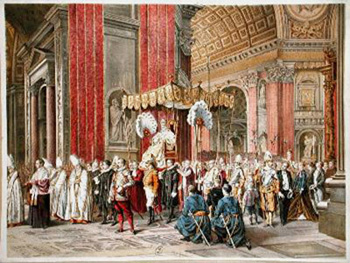 Besides, as symbols of the rightful exaltation of the Church, the Tiara and the “Triumphal Chair” point not to the person of the Pope, but to his office, and beyond that to the One Who founded the Church, whom he represents. These trappings of royalty were seen in Tradition as visual aids for the mind to assimilate the transcendent truth of the Kingship of Christ exercised by His Vicar on earth.
Besides, as symbols of the rightful exaltation of the Church, the Tiara and the “Triumphal Chair” point not to the person of the Pope, but to his office, and beyond that to the One Who founded the Church, whom he represents. These trappings of royalty were seen in Tradition as visual aids for the mind to assimilate the transcendent truth of the Kingship of Christ exercised by His Vicar on earth.
Earlier in that same century, Pope Pius XI had issued his Encyclical Quas primas (1925) by which he inaugurated the Feast of Christ the King. This has inspired the Catholic faithful to defend the Church against attack; and some, notably Fr. Miguel Pro, have given their lives for the cause.
But after Vatican II, few Catholics would think of rallying behind the banner of Christ the King. Such loyalty to the Faith is considered by progressivist theologians to be so objectionable that any display of papal supremacy – spiritual or temporal – is now regarded, to quote Ratzinger again, as “dangerous.”
The Tiara 'an impediment to Christian unity'
Pope Benedict had a personal interest in discontinuing the Tiara, which explains why he considered it such a danger that it had to be discarded. As a young revolutionary firebrand at Vatican II, acting under the auspices of Card. Frings who was President of the German Bishops’ Conference and a strong opponent of Roman centralism, he thought that the symbolism of the Tiara would jeopardize the success of two of Vatican II’s key progressivist ideas which both he and Frings wished to promote: Collegiality and Ecumenism.
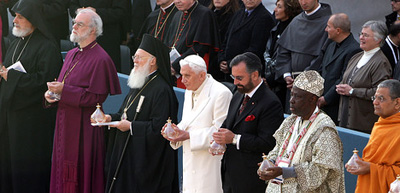 First, Ratzinger did not accept the traditional teaching that the government of the Church is monarchical, with the Bishops owing subservience and obedience to the Pope. He favored a more communitarian approach, and saw collegiality of the Bishops as an antidote to papal supremacy insofar as it would “supplement and correct the monarchic idea.”(4)
First, Ratzinger did not accept the traditional teaching that the government of the Church is monarchical, with the Bishops owing subservience and obedience to the Pope. He favored a more communitarian approach, and saw collegiality of the Bishops as an antidote to papal supremacy insofar as it would “supplement and correct the monarchic idea.”(4)
But Christ founded the Church as a Kingdom, not a People’s Republic. In other words, the basic structure and inner meaning of the divinely-appointed Constitution of the Church is monarchical, not democratic.
Second, there was the “ecumenical” question which, for progressivists, involved compromising the Faith by conciliating those outside the Church who rejected papal supremacy. Ratzinger explained:
“All the work of the Council was in a sense centred on the ecumenical problem. …This involved a readiness to see and admit the mistakes of the past, and to make amends for them, and the determination to remove every impediment standing in the way of unity.” (5)
He further stated that “the problem of papal centralism is readily understandable to everyone. Even the person indifferent to religion sees the papal primacy as an obstacle to the unity of Christendom.”(6)
The effects of such corrosive criticism coming from those who are embarrassed by the history, traditions and the teachings of the Church – which became de rigueur after Vatican II – were noted by Romano Amerio:
“The present denigration of the Church’s past by clergy and laity is in lively contrast with the courage and pride with which Catholicism confronted its adversaries in centuries past. … In the wake of the radical innovation that has occurred in the Church, and the consequent rupture of historical continuity, respect and reverence have been replaced by the censure and repudiation of the past.”(7)
Placing the Gospel under a bushel
On the occasion of his taking possession of the Chair of the Bishop of Rome at his Cathedral, the Basilica of St. John Lateran, Pope Benedict XVI, having eschewed the Tiara, stated:
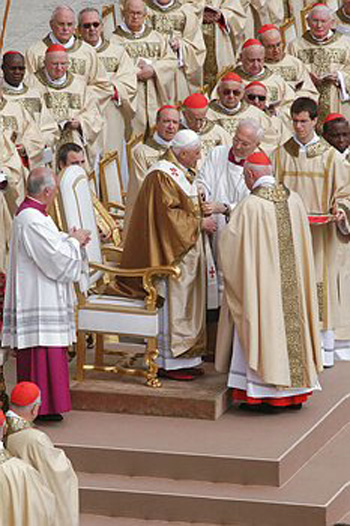 “The Pope is not an absolute monarch whose thoughts and desires are law.”(8)
“The Pope is not an absolute monarch whose thoughts and desires are law.”(8)
This statement is problematic because the word “absolute” is undefined. That the Catholic Church is an absolute monarchy is plainly shown by her institution and her history. She is ruled by the Pope who is an “absolute” monarch in the sense of absolutus in Latin – one who possesses in himself alone the fullness of supreme power, whose rule is independent, free and unrestricted by anyone else.
While this is not addressed in Ratzinger’s statement, attention is diverted from this primary truth by emphasizing a secondary, irrelevant point about laws not being made on the personal whim of the Pope. Of course, the Pope is not an absolute monarch in that sense. But to mention what he is not, while omitting to say what he is, leaves a negative connotation in the listener’s mind.
The lasting impression is that the Pope is not a monarch at all. This impression is reinforced by the decision of post-Vatican II Popes not to wear the Triple Crown. This simply demonstrates that the traditional pope-as-monarch concept is now considered so unacceptable that it must not even be mentioned.
A blot on the escutcheon
In Pope Benedict XVI’s personal coat of arms, (9) the Tiara with its clear, unambiguous meaning has disappeared and is replaced by a mitre with three gold stripes. This turned out to be an exercise in dissimulation and prevarication. The symbolism here is artfully ambiguous, for any Bishop of the Roman Rite (including the Pope) can wear a mitre, but only the Pope can wear the Tiara.
For some – progressivist Catholic Bishops, members of the so-called Orthodox and Protestant groups – it could be taken to mean that the Pope is simply the Bishop of Rome, with no jurisdiction outside the Eternal City – as in the Book of Common Prayer’s famous taunt; (10) others see in the three stripes a faint hint of the three crowns of the Tiara, but which lacks conviction or force.
Nor does the official Vatican explanation (11) clear up any confusion, but rather adds to it. No mention is made of the supremacy of the Pope’s universal jurisdiction, but only a reference to some vague “sharing” of power among brother-bishops as a “visible sign of collegiality and subsidiarity.”
Some unforeseen ironies
But as with all attempts to diminish or eradicate Catholic Tradition, the Faith cannot be entirely uprooted from the hearts and minds of the ordinary faithful. Here are some examples of how things “went wrong” for the reformers and produced unintended consequences.
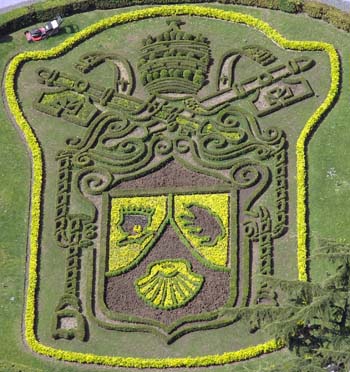 In the Vatican Gardens there is a topiary display made from low, carved and trimmed hedges specially designed in the shape of each new Pope’s coat of arms. Before Benedict XVI’s deviation from Tradition, papal heraldry had for centuries featured a personalized shield surmounted by the Tiara and the Keys of St. Peter.
In the Vatican Gardens there is a topiary display made from low, carved and trimmed hedges specially designed in the shape of each new Pope’s coat of arms. Before Benedict XVI’s deviation from Tradition, papal heraldry had for centuries featured a personalized shield surmounted by the Tiara and the Keys of St. Peter.
But when the Vatican gardeners dug out the plants representing the previous Pope’s arms and replaced them with new ones for Pope Benedict, they left those representing the Tiara and Keys undisturbed. Perhaps these hardy perennials of the Faith were too deeply embedded in the Catholic soil to be uprooted. However, we are now faced with the anomalous situation of two co-existing papal coats of arms for the same person – one in keeping with Tradition, and the other out of kilter with it.
What was the Catholic world’s surprise when, one Sunday in October 2010, the traditional design, complete with the Triple Crown, made a sudden and unexpected come-back on a tapestry hanging from the balcony of Benedict XVI’s apartment overlooking St. Peter’s Square.
This sparked rumours about a possible change in direction of papal policy regarding the Tiara, but Vatican spokesman, Fr. Federico Lombardi, SJ, who did not seem to be able to explain the anomaly other than as “a gift,” hastened to assure the public that it would not be displayed again in that form. (12) Evidently, the unnamed donor was not too ashamed to emblazon the “unwelcome” symbol of papal supremacy across the Pope’s balcony for all to see.
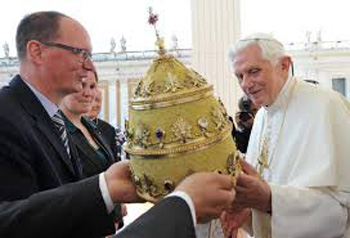 Another unexpected contingency occurred in May 2011 when Pope Benedict XVI was presented with a Tiara as a gift from some visiting German pilgrims, his own compatriots. The leader of the group obviously lamented the passing of the Tiara, for he said that he “would be very happy if we had a Pope who was crowned again like a king or a queen.”(13)
Another unexpected contingency occurred in May 2011 when Pope Benedict XVI was presented with a Tiara as a gift from some visiting German pilgrims, his own compatriots. The leader of the group obviously lamented the passing of the Tiara, for he said that he “would be very happy if we had a Pope who was crowned again like a king or a queen.”(13)
His sentiments were immediately echoed by a multitude of Catholics on the social media and assorted websites. The incident drew public attention to the inappropriateness of discarding the papal Tiara in the face of the robust sensus fidei of the ordinary faithful who wanted the Popes to retain the coronation ceremony with all its pomp and glory.
However, Pope Benedict XVI did not wear the Tiara during his Pontificate. Nor did Pope Francis wear the one specially made for him and presented to him in 2016. (14) These, as with most valuable gifts given to the Popes, were destined for the Vatican Museums.
Continued
“So long as the Church is on pilgrimage on the earth, she has no ground to boast of her own works. Such self-glorification could become more dangerous than the Sedia Gestatoria (1) and the Tiara, which are more likely to elicit a smile than a feeling of pride.” (2)

Pointing to the burning flax, the cleric entones Thus passes the glory of the world'
These words served as a reminder to the Pope of the transitory nature of earthly life and worldly honors, lest he should be tempted to see his position in terms of self-glorification. Nothing could be more calculated to dampen the fires of pride in power than the flax-burning rite.
The flax plant had been associated from Old Testament times with all that is fragile and transient, making it a suitable symbol for the brevity of our earthly existence. (3) Its rapid consumption by fire was a visual reminder to the Pope that he would soon return to dust – the perfect antidote to personal vanity in the exercise of power.

The magnificent symbols of the Papacy faded away after Vatican II
Earlier in that same century, Pope Pius XI had issued his Encyclical Quas primas (1925) by which he inaugurated the Feast of Christ the King. This has inspired the Catholic faithful to defend the Church against attack; and some, notably Fr. Miguel Pro, have given their lives for the cause.
But after Vatican II, few Catholics would think of rallying behind the banner of Christ the King. Such loyalty to the Faith is considered by progressivist theologians to be so objectionable that any display of papal supremacy – spiritual or temporal – is now regarded, to quote Ratzinger again, as “dangerous.”
The Tiara 'an impediment to Christian unity'
Pope Benedict had a personal interest in discontinuing the Tiara, which explains why he considered it such a danger that it had to be discarded. As a young revolutionary firebrand at Vatican II, acting under the auspices of Card. Frings who was President of the German Bishops’ Conference and a strong opponent of Roman centralism, he thought that the symbolism of the Tiara would jeopardize the success of two of Vatican II’s key progressivist ideas which both he and Frings wished to promote: Collegiality and Ecumenism.

The ecumenical Benedict presided over an interfaith encounter for peace: Assisi, 2011
But Christ founded the Church as a Kingdom, not a People’s Republic. In other words, the basic structure and inner meaning of the divinely-appointed Constitution of the Church is monarchical, not democratic.
Second, there was the “ecumenical” question which, for progressivists, involved compromising the Faith by conciliating those outside the Church who rejected papal supremacy. Ratzinger explained:
“All the work of the Council was in a sense centred on the ecumenical problem. …This involved a readiness to see and admit the mistakes of the past, and to make amends for them, and the determination to remove every impediment standing in the way of unity.” (5)
He further stated that “the problem of papal centralism is readily understandable to everyone. Even the person indifferent to religion sees the papal primacy as an obstacle to the unity of Christendom.”(6)
The effects of such corrosive criticism coming from those who are embarrassed by the history, traditions and the teachings of the Church – which became de rigueur after Vatican II – were noted by Romano Amerio:
“The present denigration of the Church’s past by clergy and laity is in lively contrast with the courage and pride with which Catholicism confronted its adversaries in centuries past. … In the wake of the radical innovation that has occurred in the Church, and the consequent rupture of historical continuity, respect and reverence have been replaced by the censure and repudiation of the past.”(7)
Placing the Gospel under a bushel
On the occasion of his taking possession of the Chair of the Bishop of Rome at his Cathedral, the Basilica of St. John Lateran, Pope Benedict XVI, having eschewed the Tiara, stated:

Benedict XVI inauguration: refusal to wear the Tiara & affirmation that the Pope is not a monarch
This statement is problematic because the word “absolute” is undefined. That the Catholic Church is an absolute monarchy is plainly shown by her institution and her history. She is ruled by the Pope who is an “absolute” monarch in the sense of absolutus in Latin – one who possesses in himself alone the fullness of supreme power, whose rule is independent, free and unrestricted by anyone else.
While this is not addressed in Ratzinger’s statement, attention is diverted from this primary truth by emphasizing a secondary, irrelevant point about laws not being made on the personal whim of the Pope. Of course, the Pope is not an absolute monarch in that sense. But to mention what he is not, while omitting to say what he is, leaves a negative connotation in the listener’s mind.
The lasting impression is that the Pope is not a monarch at all. This impression is reinforced by the decision of post-Vatican II Popes not to wear the Triple Crown. This simply demonstrates that the traditional pope-as-monarch concept is now considered so unacceptable that it must not even be mentioned.
A blot on the escutcheon
In Pope Benedict XVI’s personal coat of arms, (9) the Tiara with its clear, unambiguous meaning has disappeared and is replaced by a mitre with three gold stripes. This turned out to be an exercise in dissimulation and prevarication. The symbolism here is artfully ambiguous, for any Bishop of the Roman Rite (including the Pope) can wear a mitre, but only the Pope can wear the Tiara.
For some – progressivist Catholic Bishops, members of the so-called Orthodox and Protestant groups – it could be taken to mean that the Pope is simply the Bishop of Rome, with no jurisdiction outside the Eternal City – as in the Book of Common Prayer’s famous taunt; (10) others see in the three stripes a faint hint of the three crowns of the Tiara, but which lacks conviction or force.
Nor does the official Vatican explanation (11) clear up any confusion, but rather adds to it. No mention is made of the supremacy of the Pope’s universal jurisdiction, but only a reference to some vague “sharing” of power among brother-bishops as a “visible sign of collegiality and subsidiarity.”
Some unforeseen ironies
But as with all attempts to diminish or eradicate Catholic Tradition, the Faith cannot be entirely uprooted from the hearts and minds of the ordinary faithful. Here are some examples of how things “went wrong” for the reformers and produced unintended consequences.

A mistake in the Vatican Gardens -
the Tiara instead of Benedict's mitre
But when the Vatican gardeners dug out the plants representing the previous Pope’s arms and replaced them with new ones for Pope Benedict, they left those representing the Tiara and Keys undisturbed. Perhaps these hardy perennials of the Faith were too deeply embedded in the Catholic soil to be uprooted. However, we are now faced with the anomalous situation of two co-existing papal coats of arms for the same person – one in keeping with Tradition, and the other out of kilter with it.
What was the Catholic world’s surprise when, one Sunday in October 2010, the traditional design, complete with the Triple Crown, made a sudden and unexpected come-back on a tapestry hanging from the balcony of Benedict XVI’s apartment overlooking St. Peter’s Square.
This sparked rumours about a possible change in direction of papal policy regarding the Tiara, but Vatican spokesman, Fr. Federico Lombardi, SJ, who did not seem to be able to explain the anomaly other than as “a gift,” hastened to assure the public that it would not be displayed again in that form. (12) Evidently, the unnamed donor was not too ashamed to emblazon the “unwelcome” symbol of papal supremacy across the Pope’s balcony for all to see.

Benedict XVI received a Tiara from German pilgrims
His sentiments were immediately echoed by a multitude of Catholics on the social media and assorted websites. The incident drew public attention to the inappropriateness of discarding the papal Tiara in the face of the robust sensus fidei of the ordinary faithful who wanted the Popes to retain the coronation ceremony with all its pomp and glory.
However, Pope Benedict XVI did not wear the Tiara during his Pontificate. Nor did Pope Francis wear the one specially made for him and presented to him in 2016. (14) These, as with most valuable gifts given to the Popes, were destined for the Vatican Museums.
Continued
- The sedia gestatoria (“Triumphal Chair”) was a silk-covered, richly adorned portable throne on which Popes were carried on the shoulders of 12 footmen on the day of their coronation ceremony and certain other solemn occasions. The immemorial custom was ended in 1978 when Pope John Paul II replaced it with a motorized “Popemobile.” Pope Francis now drives himself around Rome in a series of old cars, or travels on public transport.
- Joseph Ratzinger, Das neue Volk Gottes: Entwürfe zur Ekklesiologie (God’s New People: Concepts for Ecclesiology). Düsseldorf: Patmos-Verlag, 1969, p. 150.
- Sometimes referred to as tow, as in the Book of Ecclesiasticus 21:10 and Isaiah 1:31. The well-known reference to “the smoking flax” in Matthew 12:20 is the fulfilment of the prophecy in Isaiah 42:3.
- Joseph Ratzinger, Theological Highlights of Vatican II, New York: Paulist Press, 1966, p. 142.
- Ibid., p. 92.
- Highlights, pp. 88-89.
- Romano Amerio, Iota Unum: A Study of Changes in the Catholic Church in the Twentieth Century, Angelus Press, 1996, p. 119.
- Benedict XVI, Homily preached at the Basilica of St. John Lateran, May 7, 2005.
- It is important not to confuse the personal coat of arms of a particular Pope with the coat of arms of the Holy See, which retains the Tiara and Keys, as the symbol of the papacy, as does the flag of the Vatican City State.
- Article 37 of the 39 Articles (1562) recognizing the English Monarch as the Supreme Governor of the Church of England stated: “The Bishop of Rome hath no jurisdiction in this Realm of England.”
- This was issued by the Apostolic Nuncio, Mgr. Andrea Cordero Lanza di Montezemolo.
- Cindy Wooden, Catholic News Service, October 14, 2014.
- Catholic News Agency, Vatican City, May 25, 2011.
- Andrea Tornielli, ‘A Tiara for Every Pope’, Vatican Insider, May 17, 2016.
Posted June 13, 2022
______________________
______________________
 Volume I |
 Volume II |
 Volume III |
 Volume IV |
 Volume V |
 Volume VI |
 Volume VII |
 Volume VIII |
 Volume IX |
 Volume X |
 Volume XI |
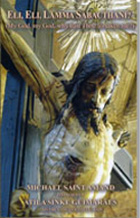 Special Edition |